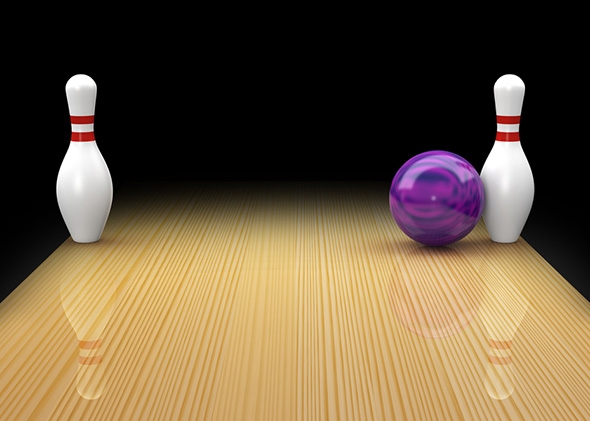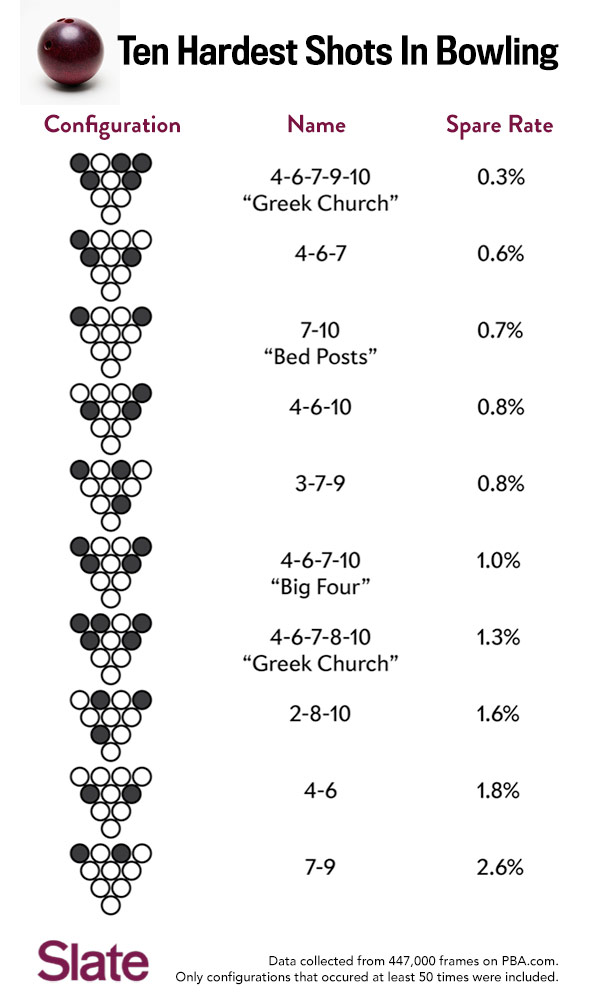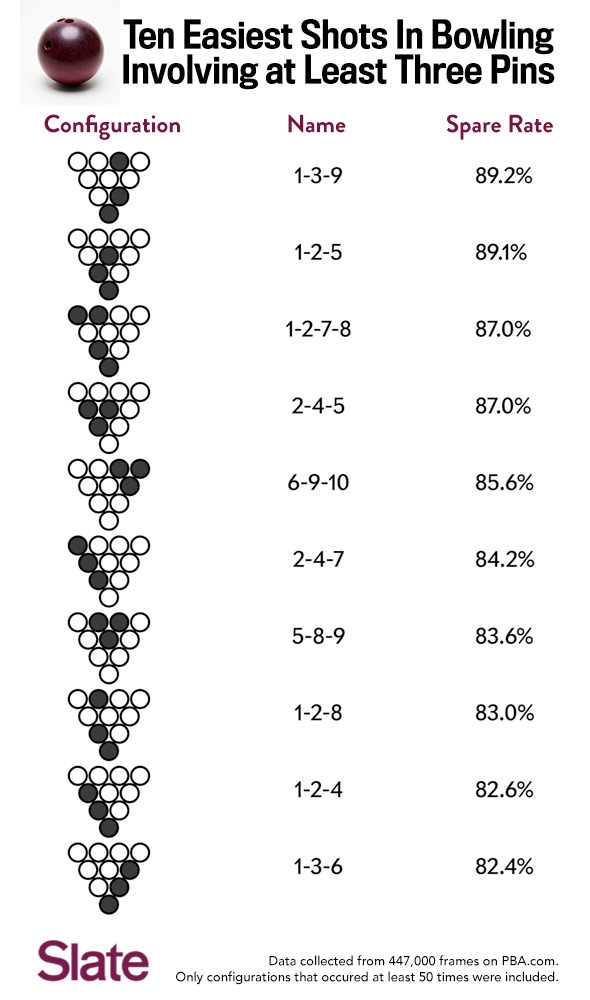What’s the Hardest Shot in Bowling?
It’s not the 7-10 split. It’s the “Greek Church.”

billdayone / Shutterstock
At a crucial moment in the classic bowling comedy Kingpin, Woody Harrelson’s character, Roy Munson, stares down a 7-10 split. “The dreaded 7-10 split,” an announcer intones. “In bowling there are 1,022 spare leads. And this, the 7-10, is by far the most difficult.”
Is the 7-10 the hardest shot in all of bowling? The announcer’s claim is certainly the conventional wisdom—quick, name another difficult split—but might there be a shot that’s more difficult?
To answer this question, I turned to the hard numbers. I gathered more than 447,000 bowling frames from PBA.com, the website of the Professional Bowlers Association. This data set includes all the PBA tournaments for which complete, frame-by-frame results were reported, dating back to 2003—447,000 frames in all. Just under 60 percent of these were strikes. But in the remaining 180,000 frames, a bowler knocked down fewer than 10 pins in the first roll. I studied those 180,000 frames to see which shots gave bowlers the hardest time.
According to my analysis, the 7-10 split is indeed one of the hardest shots in the game. In my sample it was converted to a spare about one of every 145 times it occurred. That’s a 0.7 percent success rate among people who bowl in the pros, so you can imagine how difficult it would be for a bowler one step above bumpers. Speaking in raw averages, the typical professional bowler makes a 7-10 split at the same rate a typical NFL kicker misses the extra point after a touchdown—in other words, not often. But it’s not the hardest shot in bowling.
There are two shots that bowlers make even less often, at least in my sample. The first is the 4-6-7 split, which had a success rate of 0.6 percent.* There’s one more pin involved here, which you might think would give bowlers more dead wood with which to cause collisions, but the data shows it is harder than the 7-10 split.
It’s worth noting that, like many splits, the 4-6-7 has a mirror image: the 4-6-10 split. That is, it’s the same configuration, just on the other side of the 10-pin triangle. For the purposes of this inquiry, I have treated mirror-image configurations as different shots. For one thing, they’re toppled at different rates, suggesting that despite their ostensible similarities they carry their own degrees of difficulty. (Perhaps the disparity is merely a function of randomness, or perhaps one shot is more difficult for right-handed bowlers.) But even if you combine all instances of the 4-6-7 and 4-6-10 splits, the overall success rate (.66 percent) is still lower than that of the 7-10 split.

Doontrav / Wikimedia Commons
And the most difficult configuration? That would be the 4-6-7-9-10 split. It's what PBA’s “Bowling Lingo” explainer calls the “Greek Church.” because its pattern is supposedly reminiscent of “an old cathedral type church with spires.” Bowlers in my sample converted that Greek Church just 0.2 percent of the time, or about once every 390 attempts. (Even if you count all instances of the 4-6-7-9-10 split with its mirror image the 4-6-7-8-10 split, the two combined have the lowest overall success rate: 0.4 percent.)
Below are the 10 most difficult pins configurations for pro bowlers to finish off, according to my sample:

It’s important to keep in mind that many combinations never occurred in my sample, or occurred very rarely, so I excluded them from my findings. For example, the 7-8-9-10 configuration (the entire last row remaining but nothing else) might be very difficult to complete, but it never occurred in the entire sample—physics wouldn’t allow it. In order to qualify for the chart below, a configuration had to appear at least 50 times, an admittedly arbitrary cutoff. The three hardest shots occurred in my data set an ample 785, 1818, and 3,069 times. But because many of the hardest setups are relatively rare—and instances of bowlers converting them even rarer—it’s hard to say with absolute certainty that one shot is definitely harder than another, even with what seems like a large sample size. The numbers are robust enough, however, to suggest that you’d be better off betting on a 7-10 conversion than a 4-6-7-9-10 conversion.
I asked Parker Bohn III, a professional bowler who ranks sixth on the list of most PBA titles, what he thinks the hardest shot is. He agrees it’s not the 7-10 split, which he described as a “very possible split,” for a good bowler at least. “It requires a good pocket shot,” he said.
He told me he believes the hardest spare to pick up is the 4-6-7-10. With a success rate of just over 1 percent in the sample, it’s close to the top of the list suggested by my data. Bohn’s played many more games than I have, and I believe him when he says it’s the split he least likes to see.
The easiest shots are less of a mystery. If one pin is left, the pros are efficient at knocking it down. When it’s just pin No. 3 (second row, on the right) the pros converted it at a rate of 97.7 percent. (According to my data, knocking down the 3 pin is the easiest shot in bowling.) Pin No. 7 (last row and on the far left) was the lone pin with the lowest conversion rate, though it’s still knocked down at a rate close to 95 percent.
Below are the 10 configurations that involve three or more pins that are the easiest for the pros to complete. As with the list of hardest shots, the numbers here are close to each other and could be swayed by a handful of different shots.

Why is the 7-10 split the most iconic bowling predicament if it's not necessarily the hardest? Bohn had as good a theory as any: “There's two pins on the opposite of the land. Most people look at it and think, There is no way I’m going to make it,” he said. “And I agree with them, 99 percent of them will never make it.”
Use the calculator at the beginning of this article to see the degree of difficulty for all the combinations you’re curious about.
*Correction, Feb. 18, 2015: This article originally misstated that the 4-7-10 and its mirror image the 6-7-10 were the second-hardest shots. The 4-6-7 is the second-hardest shot. (Return.)